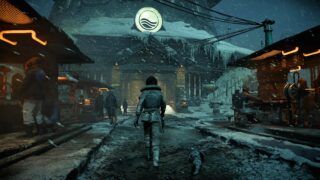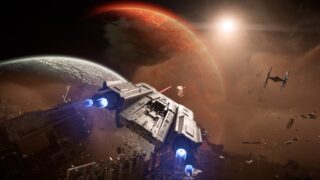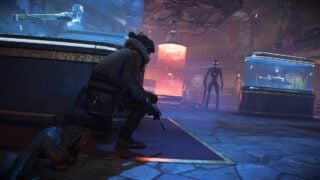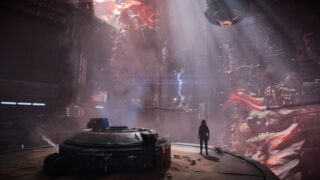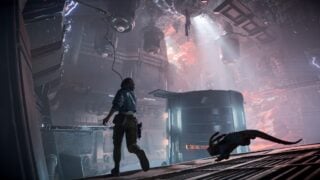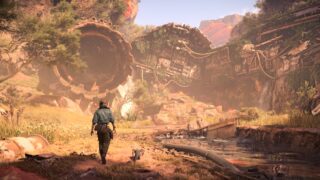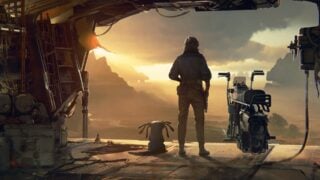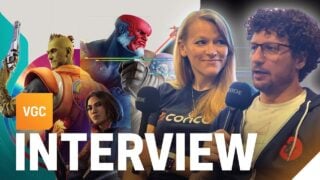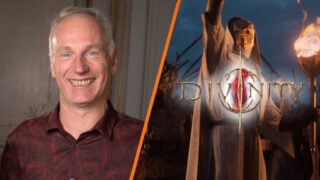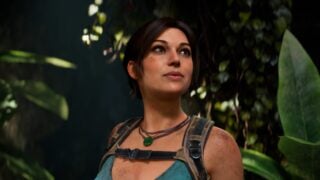Star Wars Outlaws interview: ‘Uncharted is a wonderful game to be compared to’
Creative director Julian Gerighty discusses the challenges of creating the first open-world Star Wars game
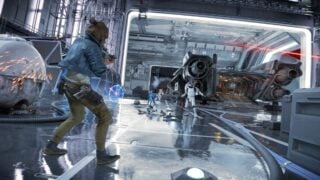
It’s unbelievable that in 2024, Star Wars is about to get only its first open-world adventure game.
The ill-fated Stars Wars 1313 – cancelled, despite an impressive E3 demo – almost claimed that title. But a decade on, Star Wars Outlaws finally looks set to deliver the third-person action-adventure shooter fans have been craving.
Developed by Ubisoft Massive (The Division), Outlaws stars Kay Vess, a scoundrel for hire, and her fuzzy and incredibly merchandisable companion Nix, the pair will blast their way through the various seedy underbellies of the Star Wars universe in the period of time between The Empire Strikes Back and Return of the Jedi.
“For Star Wars Outlaws, the core idea on the first day was: Open-world, Star Wars, Scoundrel,” explained creative director Julian Gerighty in a recent interview. “With that, even the locations are shortlisted, right? You need hives of scum and villainy, there are criminal syndicates, the Empire is present, all of these things that really make the game sing, it becomes, at least working with a partner like Lucasfilm Games, really easy and really pleasurable.”
Gerighty claimed that, despite the myriad of games, television shows and movies that have covered The Original Triology, the idea for Outlaws came together quite naturally.
“In my wildest dreams, I’d have never bet on the Original Trilogy and between Empire Strikes Back and Return of the Jedi. it was Lucasfilm Games that suggested it.
We pitched it, and they said we have one year between those movies where the Empire has taken more and more control, almost wiped out the Rebels, there are pockets of resistance, but in the absence of order, the criminal syndicates are ruling the universe, and that’s a perfect context for a scoundrel story, so it came from them. It’s my favourite part of the different eras of Star Wars, so it’s a childhood dream come true.”
Read on for VGC’s full interview with Star Wars Outlaws creative director Julian Gerighty.
It’s the second time Ubisoft has worked on a Star Wars game, the last one was 20 years ago on Game Boy Advance. Could you speak to the new challenges and advantages of working on an external IP, then versus now?
There are obvious things like brand recognition, which are incredible advantages. For me and the team, what has been incredible has been to learn from people who really know the galaxy and create that galaxy.
Massive has always been very good at crafting worlds. I don’t know if you played The Division or The Division 2, but the crafting of the world is remarkable. But working and collaborating with Lucasfilm Games has allowed us to really level up. You may think you know Star Wars, but until you get to work on Star Wars, you don’t really know Star Wars. You don’t know what it takes to design a blaster, a starship, all of those things that make something feel really Star Wars.
When making a game as a creative, is it easier or harder to be presented with all that lore and history up front, as opposed to having to create a world from scratch?
I think it’s an advantage. This project was done in four years, not short, not long, it’s not bad. One year was in Covid, so we’ve been very focused, we’ve moved in an extremely precise way in order to produce the game. I think Lucasfilm Games gave us the creative framework in which we could play. Having a framework is always fantastic. It allows you to pinpoint exactly what you want to do.
For Star Wars Outlaws, the core idea on the first day was: Open-world, Star Wars, Scoundrel. With that, even the locations are shortlisted, right? You need hives of scum and villainy, there are criminal syndicates, the Empire is present, all of these things that really make the game sing, it becomes, at least working with a partner like Lucasfilm Games, really easy and really pleasurable.
When working on a franchise like Star Wars and trying to tell an original story, is it difficult to find a pocket of time that hasn’t been largely covered by other media, especially in The Original Trilogy?
In my wildest dreams, I’d have never bet on the Original Trilogy and between Empire Strikes Back and Return of the Jedi. it was Lucasfilm Games that suggested it. We pitched it, and they said we have one year between those movies where the Empire has taken more and more control, almost wiped out the Rebels, there are pockets of resistance, but in the absence of order, the criminal syndicates are ruling the universe, and that’s a perfect context for a scoundrel story, so it came from them. It’s my favourite part of the different eras of Star Wars, so it’s a childhood dream come true.
You make it sound like it all came together quite naturally.
Extremely naturally, because you need the story, the themes, and the player fantasy all to fit together for it to feel like Star Wars, if some elements are off, it won’t feel like it’s part of that universe, part of that era of the timeline.

The game has received some positive responses following the showing at Ubisoft Forward, but there have also been some negative hands-on previews as well. Do you think the demo here is representative of what players should expect when they play the game for themselves?
Coming into a show like this while you’re finishing a game, you have to make a lot of choices, and our producer told us that we get one demo to take to all these shows we’re going to, so Gamescom, Comic-con etc.
They’re consumer and journalist-focused. We had to choose something that was a 20-minute bite-size chunk with lots of variety, lots of representative systems, but not the open-world portion. We’ll spend a lot more time on those things. This is a starter, rather than a main course.
So you think some of those criticisms will be answered?
I think we have a very compelling overall game, and I think just a part of it is represented in our current demo.
A lot of people refer to the game as “Star Wars Uncharted.” Do you think that’s reductive or a fair comparison?
It wasn’t necessarily our reference point. It’s such a wonderful game to be compared to, if you’re going to be compared to somebody, it might as well be the best in the industry. Naughty Dog and what they do is absolutely brilliant, I’ll take it. It wasn’t the point of origin.
As a creator, what challenges do you face when other developers are also making Star Wars games? The EA Star Wars Jedi games, for example, recently released to critical acclaim.
That’s where the collaboration with Lucasfilm Games is so important. On one side they’re there to guarantee authenticity, but they also want to shepherd us to a vision and a player fantasy that is exclusive to us. The other games are completely different fantasies, we work hand in hand.
“I think we have a very compelling overall game, and I think just a part of it is represented in our current demo.”
Were you able to put everything into the game that you wanted within the confines of the license, and what challenges does that present?
As a creator, I’m a big believer in setting an initial vision that’s exciting, ambitious, and achievable. It’s super important that everybody who’s working on the game shares that vision. On Star Wars Outlaws, that vision has been 95% respected. Some things are added, and a few things have been changed or removed, but very, very little.
For example, we wanted swimming. In the first few iterations of the pitch, we’d have loved to have swimming, but it’s not possible in terms of the scope. We can live without it. None of the minigames we have were there originally, so there’s a little bit of give and take.
The game prominently features factions and characters from the films, like Qi’ra from Solo: A Star Wars Story, did Lucasfilm offer any other connections to the lore they thought should be made?
It comes back to the player’s fantasy. As soon as you say that, you think about who it makes sense to cross paths with. So characters like Qi’ra and Lando, but at the same time, you don’t want the universe to feel too small, and you don’t want to do exclusively fan favourite after fan favourite.
You mentioned this was a swift production in the context of AAA, but more broadly, how do you protect your game from shifting market trends when the game may be based on a vision you came up with more than half a decade prior?
On Star Wars, we’re shipping what we planned to ship. The vision was an action-adventure scoundrel experience within an open world. We weren’t particularly monitoring trends four years ago and it didn’t influence what we wanted to do. It’s a one-shot type of deal, how many times in your life do you get to work on Star Wars?

How do you balance scale and detail in an open-world of this size?
I think it comes down to team size and ambition. Very early, we said this would be a 25-30 Golden Path adventure, 50-60 hours completionist, and from a guy with a family and job and a fair amount of time, but it’s not Assassin’s Creed 200-hour epic, that allows us to really focus on the detail, and focus on executing something that’s manageable.
The demo features a reputation system, how does that work in relation to the main story?
It doesn’t impact the main story, there are choices in the main missions, but the reputation system in the wider game reflects in things like vendors, contracts, and exclusive bounties, it’s a really desirable thing to get to a good reputation or have a terrible reputation and have people chasing you down.
Massive worked on Avatar and now Star Wars. While other publishers are now somewhat moving away from licensed titles, is it your wish as a creative to continue to do?
There are so many stories in Star Wars Outlaws that we’d like to tell and characters to come across. The timeline is perfect, there’s a lot of potential there.



